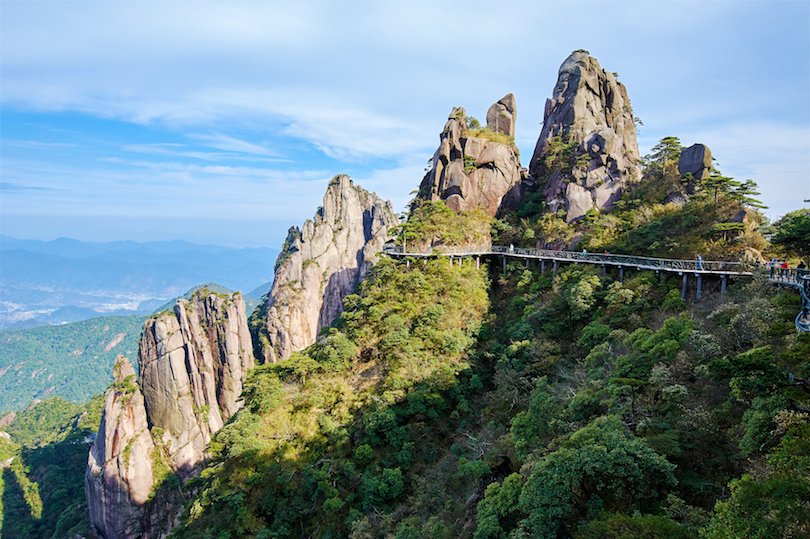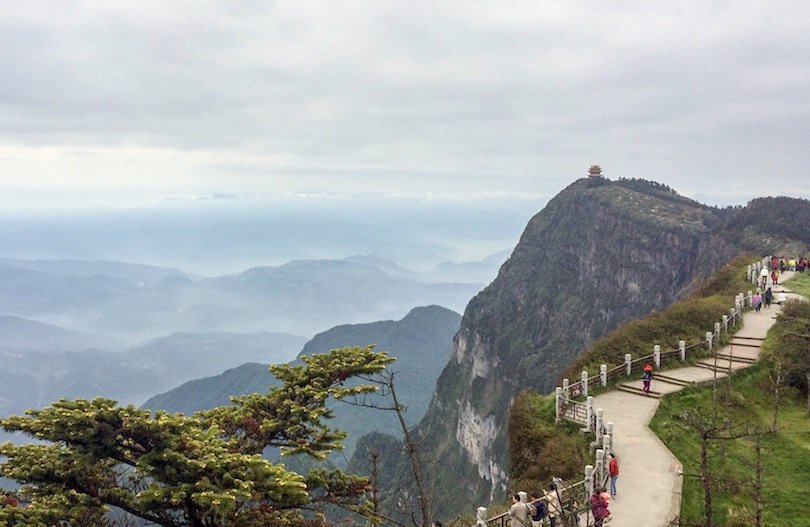12 Most Beautiful National Parks in China. It may not be the first country that comes to mind when thinking about national parks, but it actually has over 200 unique national parks within its borders. In recent years, the Chinese government has been actively working to expand its national parks system. This initiative aims to combat pollution, protect natural resources, and preserve the diverse range of animal species that inhabit these areas.
China’s vast size contributes to its status as one of the most biodiverse countries in the world. Consequently, these national parks offer an extraordinary array of plant and animal life, as well as captivating geological formations and breathtaking waterways.
Moreover, the national parks in China serve as important sites for historical preservation. Within these parks, visitors can explore relics from the past, religious temples, and spiritual landmarks, all of which provide a glimpse into China’s rich history amidst a beautifully natural backdrop.
Potatso National Park

Potatso, the inaugural national park in mainland China, is renowned for its distinctive ecological composition comprising two lakes, expansive pastures, lush forests, and marshlands. Within the park, one can leisurely observe wild yaks and horses grazing. Situated on the Tibetan plateau, the park rests at an elevation of 3500 meters above sea level.
This region holds immense spiritual significance for the Tibetan people, attracting numerous devotees who embark on pilgrimages to the park annually. Interestingly, the park’s name in the Tibetan language loosely translates to “to ferry people away from suffering”.
During the summer, the park blossoms with hundreds of vibrant flowers, while the fall season adorns it with a kaleidoscope of changing leaves. Irrespective of the time of year, Potatso remains a picturesque destination.
Sanqingshan National Park

The landscape of this stunning national park is adorned with granite peaks and pillars that create a truly otherworldly atmosphere. Alongside these magnificent formations, you will find lush forests, deep valleys, and cascading waterfalls. The park takes its name from Mount Sanqing, which boasts three prominent summits known as the ‘one pures’. These summits symbolize the Taoist trinity: Yuhua, Yushui, and Yujing. Consequently, the park has served as a sacred destination for Chinese Taoists for more than 1500 years.
While the park’s natural beauty is awe-inspiring, it is also home to ancient temples and relics that add a touch of history to the surroundings. With over 2000 species of plants, including the ethereal rhododendrons that blanket the mountains in May and June, this park truly offers a mesmerizing experience.
Huanglong National Park

This particular national park holds a unique charm. It showcases a collection of vibrant, petrified pools and lakes nestled amidst valleys and lush forests. These pools are adorned with stunning hues of turquoise, deep blues, and vibrant yellows.
The water that fills these pools originates from the glaciers and mountain ranges that surround the area. Additionally, visitors can explore caves and waterfalls within the park. Moreover, the park is home to two renowned Taoist temples: Back and Ancient Temple. Occasionally, the mountains in the vicinity are crowned with a layer of snow, further enhancing the park’s already awe-inspiring beauty.
Emeishan National Park

This enchanting park is the residence of the highest among the four sacred Buddhist mountains in China, Mount Emei. Standing tall at an elevation of 3099 meters above sea level, visitors are occasionally treated to a mesmerizing spectacle of clouds from its summit. The mountain itself holds great significance as a traditional site of enlightenment and boasts more than 100 temples and monasteries.
Among the most renowned attractions are the Golden Summit, Baoguo Temple, Wannian Temple, and Qingyin Pavilion. Each of these sites offers breathtaking views of the surrounding natural beauty. Due to its profound spiritual importance to the Buddhist community, the mountain attracts hundreds of pilgrims every year. Within the park, one can also discover rare floral species and encounter indigenous animals such as Tibetan Macaques and a diverse array of monkeys.
Shilin National Park

This extraordinary national park is renowned for its unique ‘stone forest’. Numerous peculiar rock formations in the park resemble fossilized trees, which has earned it the nickname. The park boasts countless trails that wind through its grounds, and it is also home to a diverse array of bird species.
Among all the stones, the ‘Ashima stone’ stands out as the most famous. According to legend, a beautiful girl from the Yi People was transformed into stone while hiding in the forest after fleeing from her home. She took this drastic step upon discovering that her parents disapproved of her love for a certain man. In addition to the stone forest, the park is adorned with caves, lakes, and waterfalls.
Huangshan National Park

Huangshan National Park is aptly named due to its yellow mountains, and the vibrant range of mountains is composed of steep granite peaks enveloped by pine trees. Numerous trees in the park appear to be barely clinging on.
For centuries, this park has captivated the minds of countless artists, particularly those who specialize in water and ink paintings, and it continues to inspire artists to this day. Many of these artists have proclaimed the Huangshan mountain range as the most beautiful in all of China. Additionally, the park boasts hot springs that provide breathtaking views. Despite the ever-changing landscape with each passing season, the park never fails to retain its distinct allure.
Guilin Lijiang National Park

Guilin Lijiang National Park stands out from any other place on the planet. Situated in the southern region of China, it stands as one of the most sought-after tourist destinations in the country. As visitors cruise along the Lijiang River, they are treated to breathtaking views of the karst formations that Guilin is renowned for. Each of these hills was bestowed with a name by the ancient Chinese, based on their perception of the formation’s appearance.
This led to the creation of whimsical names like Elephant Trunk Hill, Cock-Fighting Hill, and Dragons Head Hill. A well-known Chinese proverb declares that “Guilin’s scenery is the best under heaven,” and many visitors wholeheartedly concur. Moreover, there is a series of renowned caves waiting to be explored within the boundaries of the park.
Jiuzhaigou National Park

This national park is truly a remarkable natural marvel. The awe-inspiring natural scenery comprises of majestic waterfalls, pristine lakes, and magnificent limestone hills. Situated within the Min Shan mountain range and on the fringes of the Tibetan Himalayan Plateau, it offers a captivating experience.
The park derives its name, Jiuzhaigou, which means “nine villages,” as a tribute to the Tibetan inhabitants residing there. Consequently, numerous Tibetan places of worship are interspersed throughout the park, harmoniously blending with the surrounding natural landscape. Moreover, Jiuzhaigou boasts an extraordinary level of biodiversity, serving as a sanctuary for several endangered species, including the iconic black and white pandas of China, the Sichuan golden monkey, and the takin.
Zhangjiajie National Forest Park

Zhangjiajie National Park is renowned for its exceptional and breathtaking beauty. The park boasts magnificent sandstone pillars, a diverse range of wildlife, and lush greenery. The towering sandstone pinnacles are adorned with evergreen shrubs, creating a mesmerizing sight that stretches towards the sky. The park is predominantly covered in natural vegetation, with a staggering 98% of its area dedicated to preserving the rich flora and fauna. It serves as a sanctuary for over 150 species of wildlife, including protected animals like the rhesus monkey, golden pheasant, musk deer, and giant salamander.
Moreover, the park is adorned with numerous streams, waterways, and valleys, providing ample opportunities for exploration and enhancing its overall allure. Without a doubt, Zhangjiajie National Park stands as a truly unparalleled destination, unlike any other place on Earth.
Huangguoshu National Park

Huangguoshu National Park, situated in Western China, boasts one of the largest waterfalls in Asia. Standing at a remarkable height and width of approximately 250 meters, Huangguoshu Waterfall is a true marvel. Behind the cascading curtain of water lies a magnificent cave, naturally sculpted and waiting to be explored.
What makes this experience even more enticing is that visitors can venture into the cave without getting wet. On sunny days, the mist from the waterfall creates a captivating rainbow against the backdrop of the park’s lush greenery.
To fully appreciate this natural wonder, there are several viewing platforms and walkways strategically placed around the falls. One of these platforms offers a breathtaking bird’s eye view of the entire spectacle. With a pleasant year-round temperature of 16 degrees Celsius, Huangguoshu National Park is an irresistible attraction no matter the season.
Lushan National Park

For centuries, this region has been a magnet for spiritual leaders. Its classical Chinese landscape, characterized by rivers, mountains, and forests, is held in high esteem. Even today, more than 200 ancient Buddhist, Taoist, and Confucius relics and temples can be found here.
Stretching from the Yangtze River to the Lake Poyang Basin, this protected area encompasses a variety of mountains, gorges, valleys, and caves waiting to be explored. With its well-connected trails and serene ambiance, it offers an ideal setting for a tranquil weekend getaway amidst the captivating beauty of nature.
West Lake National Park is one of the 12 Most Beautiful National Parks in China

West Lake National Park boasts the stunning West Lake as its picturesque centerpiece. Within the park, visitors can leisurely stroll along the numerous trails that wind their way around the lake, offering breathtaking views of the surrounding mountain range and the Hangzhou skyline. Scattered throughout the park are temples, pagodas, and various gardens, creating a serene and tranquil atmosphere.
The gardens and the lake itself have long been a source of inspiration for poets, painters, and other artists throughout history. Today, West Lake National Park is recognized as one of the finest examples of well-preserved classical gardens in Fuzhou. To experience a different perspective, a boat ride is highly recommended as it allows visitors to fully immerse themselves in the natural beauty of the park.





